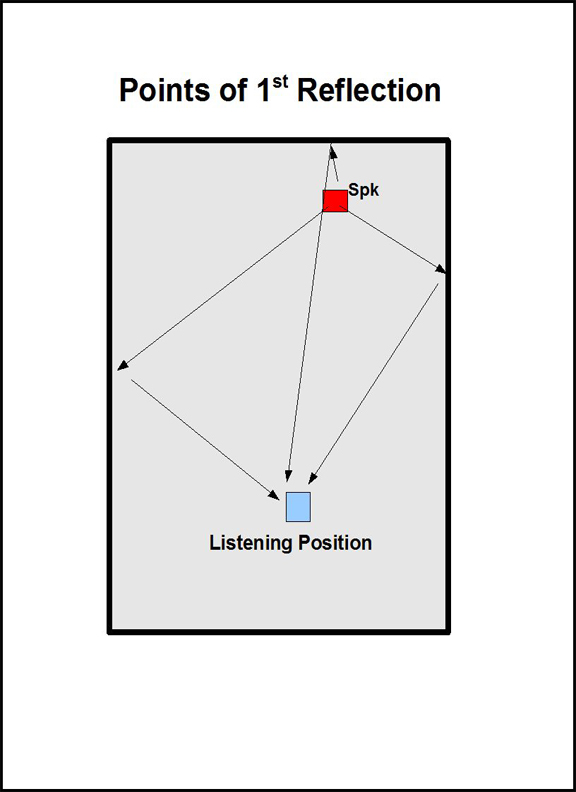Ed's
AV Handbook
Batting practice for the AV Professional
and primer for the novice
Chapter
6 Page 3
The Room, Speaker, & TV
The Room Continued
House of Mirrors
Imagine a room of mirrored
boundaries -- the floor, ceiling, and walls. Then
envision viewing a large screen television in this mirrored
room with images reflected and repeated from all
directions. This chaos of images can cause visual
disorientation and a splitting headache.
Similarly, room boundaries are acoustic mirrors.
Acoustical-reflections from all room boundaries follow the
direct sound from a speaker from all directions.
The reflections of the middle and high frequencies can cause
acoustic disorientation of the sound fields and distort
harmonic detail. The control of these reflections is
critical for high fidelity sound reproduction. Taming
these reflections is a function of absorbing and or diffusing
their amplitude.

First reflections
The most significant reflections
are the first arriving reflections. Locate the source of
these reflections with a mirror. Place a mirror at a
room boundary.
While sitting at a listening position, have someone move the
mirror along the room boundary. The 1st reflection
points are at all speaker reflections viewed in the mirror
from the listening position.
Place acoustical-absorption at the first points behind, above,
and in front of all speakers to dampen the reflections.
Use heavy drapery, plush furniture, acoustic foam panels, and
carpet with extra padding.
Acoustic option
Lateral reflections can add a
subjective element to the situation. More lateral
absorption creates the acoustical-image of a smaller
space. Less lateral absorption recreates the impression
of a larger acoustical-space. You may produce the
acoustical stereo image that you prefer by applying more or
less lateral absorption. However, too much absorption
will create a dull sounding room.
Note for the
smaller room
If a seating position must be at the rear room boundary,
then place acoustical absorption at ear level to dampen the
acoustic mirror behind the seating. Then place
acoustical diffusion to the left and right of the absorption
to psycho-acoustically move the sound farther away.
Open-cell foam absorption panels, diffuser panels,
furniture, book filled bookcases, and plants provide
effective options.
Uninvited Noise
If undesirable noise
from adjoining areas merges with your music or movie
soundtrack, it will obscure sound fields and harmonic
detail. Conversely, sound exiting the sound room can
compete with an adjoining area's activities.
Therefore, suppress the transmission of noise too and from
the room.
Trapped air and mass are the two components that are most
effective at stopping the transmission of sound through room
boundaries. The measurement of how effective any
material blocks sound through itself is the Sound
Transmission Class or STC. The higher the STC value,
the better its noise suppression. Many manufactures
and industrial associations offer STC data on their
construction and acoustical product.
However, all construction and acoustical product have a
unique resonant frequency, a natural ring, at which they
virtually become an open window to that resonating
frequency. Therefore, consider the construction of an
acoustic sandwich of different materials such as Sheetrock,
acoustic insulation, acoustic vinyl, and air space.
Each layer closes another's resonant window and adds to the
STC value of the walls, floor, and ceiling.
As an example, construct two stud-framed walls with one inch
spacing between the walls. Hang dense mineral fiber
insulation between the studs.
Cover the walls with a 1/8 inch dense, thick limp-mass vinyl
blanket. Consider adding a sandwich layer of
Sheetrock, the vinyl blanket, and another layer of
Sheetrock. Attach this sandwich to the wall with
isolating metal channel fasteners.
The sum of the
layers close the resonant windows and substantially improve
the STC rating of the boundary. Consider the same
techniques for the floor and ceiling. Additional floor
isolation is available via dedicated floor-isolating
products from several manufactures.
Next, reduce noise originating from the heating and cooling
system. Install a dedicated, larger ventilation
duct. Line the vent duct with lightly painted
fiberglass board. Suspend it with rubber tie-down
straps; rather than loose metal straps and nails. Wrap
the metal vent in a noise suppression material such as the
viny blanket mentioned earlier.
How about the windows? The perfect answer is "what
window"? However, if windows are necessary, select a
dual-pane or install two separate parallel windows.
Float the window structure on isolating vinyl material as
used on the wall. Next, select an exterior grade solid
core door. Finally, sound as air and water will flood
through any small gap. Therefore, seal, dampen and,
isolate gaps in windows, doors and, electrical outlets.
Remaining Issues
Three significant
room issues remain.
1. Room color
2. Room lighting
3. Speaker and listener placement.
The balance of this Handbook chapter addresses each each
issue via the "The Speaker System, and The TV.
Shut the Door
That closes the door
on 'The Room'.
-- We have drawn curtains over acoustical mirrors.
-- We have identified room mode peaks and nulls.
-- We have sited safe harbor from peak-null acoustical
swells.
-- We have shown our noisy guest the door.
Now let's put speaker in the room.
Copyright 2007 Txu1-598-288 Revised 2024
Sponsored By

Architectural Speaker Tuning System
Site Menu
Home
Table of
Contents
Handbook Chapters
1 AV
Terms
2 AV Physics
3 Sound Reproduction
4 Video Reproduction
5 The AV System Sequence
6 The Room, Speaker, & TV
7 Acoustical Strategy - Small Room
8 Home Theater by Design
9 AV Sales Training
10 AV Business & Marketing
Contact
About
